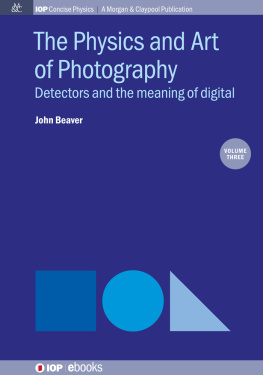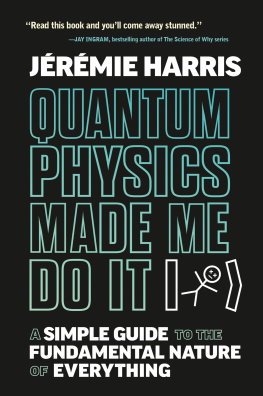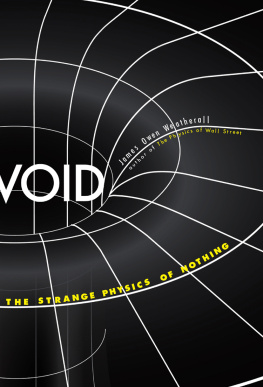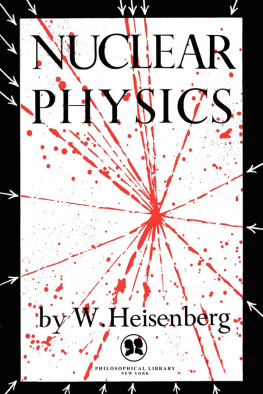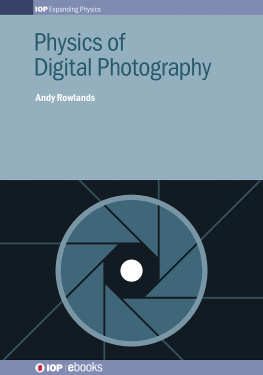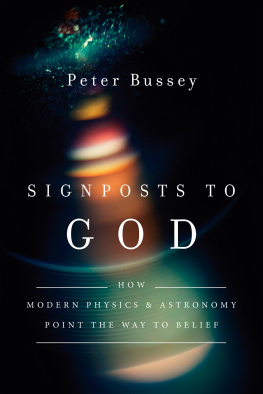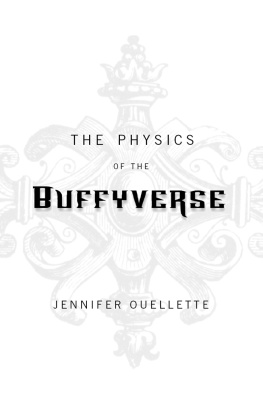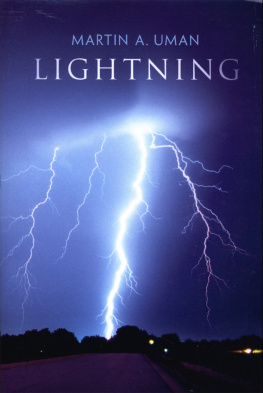Contents
Contents
The Physics and Art of Photography, Volume 3
Detectors and the meaning of digital
John Beaver
University of Wisconsin Fox Valley, Menasha, WI, USA
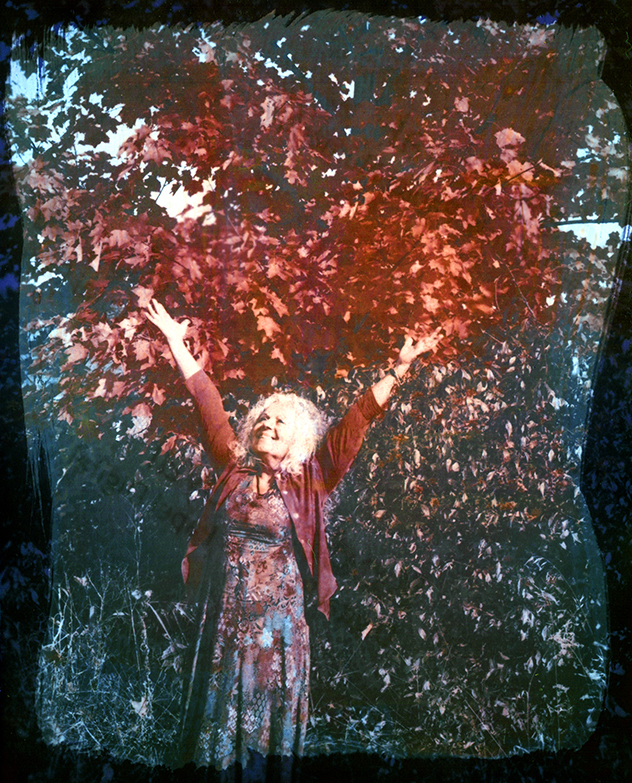
Morgan & Claypool Publishers
Copyright 2018 Morgan & Claypool Publishers
All rights reserved. No part of this publication may be reproduced, stored in a retrieval system or transmitted in any form or by any means, electronic, mechanical, photocopying, recording or otherwise, without the prior permission of the publisher, or as expressly permitted by law or under terms agreed with the appropriate rights organization. Multiple copying is permitted in accordance with the terms of licences issued by the Copyright Licensing Agency, the Copyright Clearance Centre and other reproduction rights organizations.
Certain images in this publication have been obtained by the author from the Wikipedia/Wikimedia website, where they were made available under a Creative Commons licence or stated to be in the public domain. Please see individual figure captions in this publication for details. To the extent that the law allows, IOP Publishing and Morgan & Claypool Publishers disclaim any liability that any person may suffer as a result of accessing, using or forwarding the images. Any reuse rights should be checked and permission should be sought if necessary from Wikipedia/Wikimedia and/or the copyright owner (as appropriate) before using or forwarding the images.
Rights & Permissions
To obtain permission to re-use copyrighted material from Morgan & Claypool Publishers, please contact .
ISBN 978-1-64327-386-0 (ebook)
ISBN 978-1-64327-383-9 (print)
ISBN 978-1-64327-384-6 (mobi)
DOI 10.1088/2053-2571/aaf0ae
Version: 20181201
IOP Concise Physics
ISSN 2053-2571 (online)
ISSN 2054-7307 (print)
A Morgan & Claypool publication as part of IOP Concise Physics
Published by Morgan & Claypool Publishers, 1210 Fifth Avenue, Suite 250, San Rafael, CA, 94901, USA
IOP Publishing, Temple Circus, Temple Way, Bristol BS1 6HG, UK
For Judith
Preface
Early drafts of this book were written for a course I first taught in the Fall of 2013 at the University of WisconsinFox Valley, in Menasha, Wisconsin.
I assume no specific prior knowledge of the reader except for a very basic understanding of physical units, dimensions and scientific notation; a brief review can be found in appendix . The mathematics presented in the text is rudimentary, with only the most basic of algebra (more detailed derivations, or those that require calculus, are relegated to the appendices). A familiarity with the material in Volumes 1 and 2 is not essential prior to reading this volume, but it is helpful.
If you have little experience with photography, it is my goal that The Physics and Art of Photography will help form a useful foundation from which to learn about photography in whatever way that works best for you. If you are a seasoned pro, but looking to set off in a new direction, then I still hope that you will find much here that is fresh and inspiring, and it is my goal that the book will help to open new possibilities. The Physics and Art of Photography is in three volumes:
Volume 1: Geometry and the nature of light
Part I: Some preliminary ideas
Part II: The nature of light
Part III: Geometry and two-dimensional design
Volume 2: Energy and color
Volume 3: Detectors and the meaning of digital
The Physics and Art of Photography covers some material that is typical of discussions that link physics and photography. But it is also personal; it is very much my own take on the two subjects. I would not say that my personal views regarding science and art are controversial, but they are perhaps somewhat unconventional. There are few details here that other artists and scientists are likely to strongly disagree with. It is, rather, what I have chosen to emphasize, what I have left out all together, and the particular connections I point to, that most shows my own personal likes and dislikes.
Since my formal training is in physics and astronomy, while I am essentially self-trained in art (with informal mentoring from many others), the science part of this book is perhaps more conventional and straightforward than is my portrayal of art. And so my choice of physics-related topics should give one a fairly balanced and conventional taste of that subject as it relates to photography. Regarding photography as an art, however, I am surely on shakier ground.
Certainly, I do not pretend to present a comprehensive or balanced overview of art photography; I am unqualified to attempt such a thing. But I do try to make a case that the particular thin slice that I present here has some merit and is worth spending a little time to consider, even if it turns out not to be your particular cup of tea. This book is a bad place to get a sense of what are the hot topics in ArtForum, but I believe that it does at least point to important and interesting questions about art photography in general. And since it is my goal to get you thinking, it doesnt matter much whether you agree with me or not. Thus, it is fitting that my discussion of art is more personal, since my own art is the wee bit for which I really do know what I am talking about.
And so one might complain that The Physics and Art of Photography is a very long artists statement, justifying the value and relevance of my own art. That may be partly true, but I do try to approach it in a way that emphasizes broad questions, rather than the particular answers I try to give (tentatively) with my own art. And I hope this book does help a little to make you a better photographer, and as such I do spend time on some of the very basic technical aspects of photography that I find important. But in doing so, I try to use these technical issues as points of departure to consider the status of photography as an art, finally exploring some issues relating to this status in the digital age.
This book may also be read as a manifesto of sorts for the aspects of science that have always moved me the most. I am interested in science not for the technological gizmos it has produced, or for some notion of inevitable human progress. Rather, science is, for me, part of the study of nature. My interest in Einsteins General Relativity, for example, is essentially the same as my interest in bird watching. Because I have spent some time to learn a bit about birds, I can now walk through the woods free of binoculars, looking only at the ground at my feet, and a world is open to me just by the sounds I hear. And when I stumble on my way up the stairs, as a physicist I can take comfort in the idea that my shin in contact with the stair prevented me from following my normal straight-line path through four-dimensional spacetime.
You will find throughout the book illustrations from my own photography as examples. This is convenient, since I know my own pictures and the stories behind them, and I dont need permission to use them. But of course I also want you to look at other photography, and so I have included some examples from a few other artists whose work I admire.

